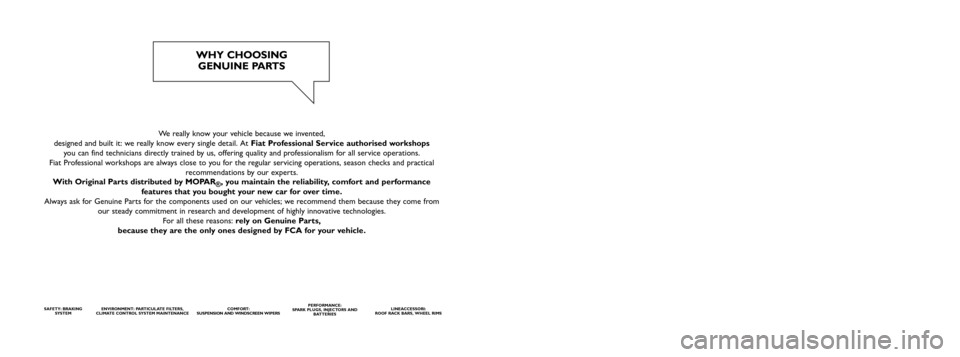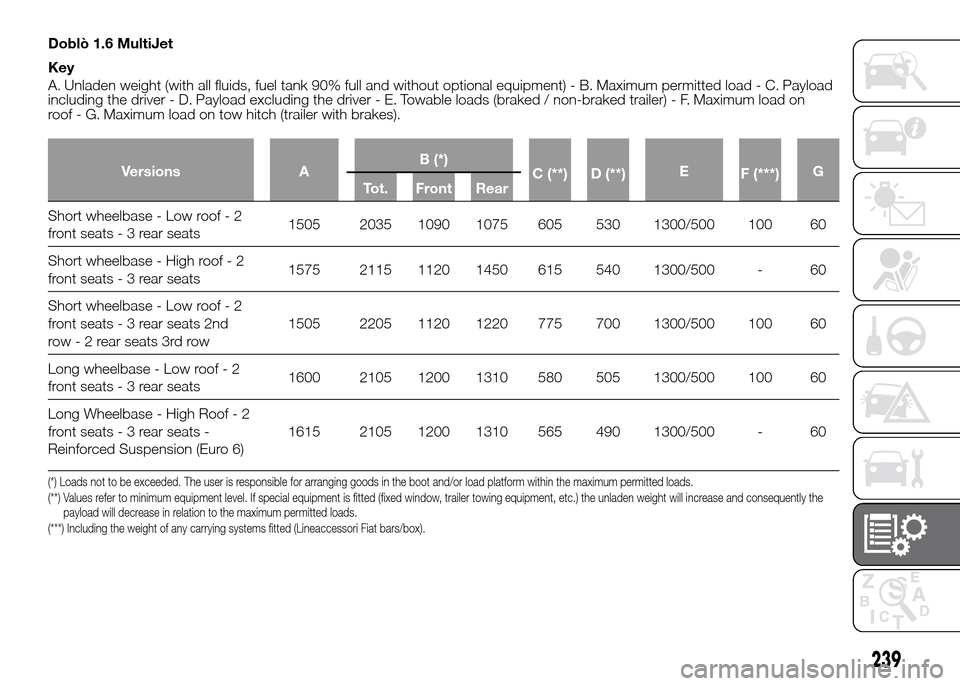Page 2 of 323

We really know your vehicle because we invented,
designed and built it: we really know every single detail. At Fiat Professional Service authorised workshops
you can find technicians directly trained by us, offering quality and professionalism for all service operations.
Fiat Professional workshops are always close to you for the regular servicing operations, season checks and practical recommendations by our experts.
With Original Parts distributed by MOPAR
®, you maintain the reliability, comfort and performance
features that you bought your new car for over time.
Always ask for Genuine Parts for the components used on our vehicles; we recommend them because they come from our steady commitment in research and development of highly innovative technologies. For all these reasons: rely on Genuine Parts,
because they are the only ones designed by FCA for your vehicle.
SAFETY: BRAKING SYSTEMENVIRONMENT: PARTICULATE FILTERS,
CLIMATE CONTROL SYSTEM MAINTENANCECOMFORT:
SUSPENSION AND WINDSCREEN WIPERSPERFORMANCE:
SPARK PLUGS, INJECTORS AND BATTERIESLINEACCESSORI:
ROOF RACK BARS, WHEEL RIMS
WHY CHOOSING GENUINE PARTS
DOBLO LUM GB_DOBLO LUM GB 07/01/15 15:11 Pagina 2
Page 149 of 323

The following conditions may influence
the performance of the parking
assistance system:
❒Reduced sensor sensitivity and a
reduction in the parking assistance
system performance could be due to
the presence on the surface of the
sensor of: ice, snow, mud, thick
paint.
❒The sensor may detect a non-
existent obstacle (echo noise) due to
mechanical noises, for example
when washing the vehicle, in case of
rain, strong wind, hail.
❒The signals sent out by the sensors
can be altered by dirt, snow or ice
deposited on the sensors or by
ultrasound systems (e.g. truck
pneumatic brakes or pneumatic drills)
near the vehicle.
❒The performance of the parking
assistance system may also be
affected by the position of the
sensors. For example by a change in
the ride setting (caused by the wear
of the shock absorbers, suspension),
changing the tyres, overloading the
vehicle and carrying out specific
tuning operations that require the
vehicle to be lowered.❒Detection of obstacles in the upper
part of the vehicle (particularly in the
case of vans or chassis cabs) may
not be guaranteed because the
system detects obstacles that could
strike the lower part of the vehicle.
❒The parking sensors work properly
with the swing doors closed.
❒If they are open, they can cause the
system to send false signals: always
close the rear doors.
❒Do not apply stickers to the sensors.
WARNING
97) The sensors must be clean of
mud, dirt, snow and ice in order
for the system to work. Be careful
not to scratch or damage the
sensors while cleaning them.
Avoid using dry, rough or hard
cloths. The sensors must be
washed using clean water, with
the addition of car shampoo if
necessary. When using special
washing equipment such as high
pressure jets or steam cleaning,
clean the sensors very quickly
keeping the jet more than 10 cm
away.98) Parking manoeuvres, however,
are always the driver’s
responsibility. While carrying out
these manoeuvres, always make
sure that no people (especially
children) or animals are in the
area concerned. The parking
sensor is designed to assist
drivers, who must still never allow
their attention to lapse during
potentially dangerous
manoeuvres even if performed at
low speed.
145
Page 208 of 323

Rear window (washer)
The rear window washer jets are fixed.
The nozzle holder is located above
the rear window.
WARNING
138) Driving with worn windscreen
wiper blades is a serious hazard,
because visibility is reduced in
bad weather conditions.
WHEELS AND TYRES
Check the pressure of each tyre,
including the space-saver wheel,
approximately every two weeks and
before long journeys: the pressure
should be checked with the tyre rested
and cold.
It is normal for the pressure to increase
when the vehicle is used; for the correct
tyre inflation pressure, see “Wheels” in
the “Technical specifications” section.
Incorrect pressure causes abnormal
tyre wear fig. 224:
Anormal pressure: tread evenly worn;
Blow pressure: tread particularly worn
at the edges;
Chigh pressure: tread particularly worn
in the centre.The tyres must be replaced when the
tread is less than 1.6 mm thick. In
any case, follow the laws in force in the
country you are in.
IMPORTANT
❒As far as possible, avoid sharp
braking, screech starts and violent
shocks against pavements, potholes
or other hard obstacles. Driving for
long stretches over bumpy roads can
damage the tyres;
❒periodically check that the tyres have
no cuts in the side wall, abnormal
swelling or irregular tyre wear.
Contact a Fiat Dealership if required;
❒avoid overloading the vehicle when
travelling: this may cause serious
damage to the wheels and tyres;
❒if a tyre is punctured, stop
immediately and change it to avoid
damage to the tyre, the rim,
suspensions and steering system;
❒tyres age even if they are not used
much. Cracks in the tread and on
the side walls are a sign of ageing.
Have the tyres checked by
specialised personnel if they have
been fitted for longer than 6 years.
Remember to check the spare wheel
very carefully;
224F0V0161
204
SERVICING AND MAINTENANCE
Page 215 of 323

TECHNICAL SPECIFICATIONS
Everything you may find useful for
understanding how your vehicle
is made and works is contained in this
chapter and illustrated with data, tables
and graphics. For the enthusiasts and
the technician, but also just for those
who want to know every detail of their
vehicle.IDENTIFICATION DATA....................212
ENGINE CODES - BODYWORK
VERSIONS ......................................214
ENGINE ..........................................216
SUPPLY ..........................................219
TRANSMISSION .............................220
BRAKES .........................................221
SUSPENSION .................................222
STEERING ......................................223
WHEELS .........................................224
DIMENSIONS ..................................231
WEIGHTS........................................237
SUPPLIES .......................................264
FLUIDS AND LUBRICANTS ............266
PERFORMANCE .............................269
FUEL CONSUMPTION ....................270
CO2 EMISSIONS ............................290
OFFICIAL TYPE APPROVALS .........302
PRESCRIPTIONS FOR HANDLING
THE VEHICLE AT THE END OF ITS
LIFE ................................................305
211
Page 226 of 323
SUSPENSION
Versions Front Rear
Front
independent wheel MacPherson typeMulti-link independent, coil springs,
telescopic shock absorbers and anti-roll bar
(according to version) Rear
222
TECHNICAL SPECIFICATIONS
Page 243 of 323

Doblò 1.6 MultiJet
Key
A. Unladen weight (with all fluids, fuel tank 90% full and without optional equipment) - B. Maximum permitted load - C. Payload
including the driver - D. Payload excluding the driver - E. Towable loads (braked / non-braked trailer) - F. Maximum load on
roof - G. Maximum load on tow hitch (trailer with brakes).
Versions AB (*)
C (**) D (**)E
F (***)G
Tot. Front Rear
Short wheelbase - Low roof - 2
front seats-3rearseats1505 2035 1090 1075 605 530 1300/500 100 60
Short wheelbase - High roof - 2
front seats-3rearseats1575 2115 1120 1450 615 540 1300/500 - 60
Short wheelbase - Low roof - 2
front seats-3rearseats 2nd
row-2rearseats 3rd row1505 2205 1120 1220 775 700 1300/500 100 60
Long wheelbase - Low roof - 2
front seats-3rearseats1600 2105 1200 1310 580 505 1300/500 100 60
Long Wheelbase - High Roof - 2
front seats-3rearseats -
Reinforced Suspension (Euro 6)1615 2105 1200 1310 565 490 1300/500 - 60
(*) Loads not to be exceeded. The user is responsible for arranging goods in the boot and/or load platform within the maximum permitted loads.
(**) Values refer to minimum equipment level. If special equipment is fitted (fixed window, trailer towing equipment, etc.) the unladen weight will increase and consequently the
payload will decrease in relation to the maximum permitted loads.
(***) Including the weight of any carrying systems fitted (Lineaccessori Fiat bars/box).
239
Page 290 of 323
.
VERSIONS CONSUMPTION
1.6 MultiJet 90 HP Euro 5 / Euro 5+ Start&Stop Urban Extra-urban Combined
Doblò 5/7-seater 6.1 4.7 5.2
Doblò 5-seater, High roof 6.3 5.2 5.6
.
VERSIONS CONSUMPTION
1.6 Multijet 95HP/120HP Euro 6 NO
Start&StopUrban Extra-urban Combined
Doblò 5/7 seats Short Wheelbase / Low Roof 6.5 4.4 5.2
Doblò 5 seats Long Wheelbase / Low Roof /
Reinforced Suspension6.8 4.7 5.5
Doblò 5 seats Short Wheelbase / High Roof /
Reinforced Suspension6.9 5.1 5.8
Doblò 5 seats (120 HP) Long Wheelbase / High
Roof / Reinforced Suspension6.9 5.1 5.8
286
TECHNICAL SPECIFICATIONS
Page 291 of 323
.
VERSIONS CONSUMPTION
1.6 Multijet 95 HP/120 HP Euro 6 Start&Stop
Eco PackUrban Extra-urban Combined
Doblò 5/7 seats Short wheelbase / Low roof 5.4 4.3 4.7
Doblò 5 seats Long Wheelbase / Low Roof /
Reinforced Suspension5.6 4.5 4.9
Doblò 5 seats Short Wheelbase / High Roof /
Reinforced Suspension6.0 4.9 5.3
Doblò 5 seats (120 HP) Long Wheelbase / High
Roof / Reinforced Suspension6.0 4.9 5.3
.
VERSIONS CONSUMPTION
1.6 MultiJet Euro 4 Urban Extra-urban Combined
Cargo Short Wheelbase 6.6 4.7 5.4
Cargo Increased payload / Short wheelbase / Long
wheelbase6.7 4.7 5.4
Cargo short wheelbase, High roof / Cargo short
wheelbase, increased payload, High roof6.8 5.1 5.7
287